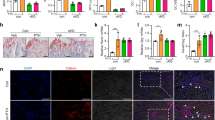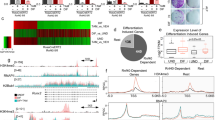Abstract
WSB-1 is a SOCS-box-containing WD-40 protein of unknown function that is induced by Hedgehog signalling in embryonic structures during chicken development. Here we show that WSB-1 is part of an E3 ubiquitin ligase for the thyroid-hormone-activating type 2 iodothyronine deiodinase (D2). The WD-40 propeller of WSB-1 recognizes an 18-amino-acid loop in D2 that confers metabolic instability, whereas the SOCS-box domain mediates its interaction with a ubiquitinating catalytic core complex, modelled as Elongin BC–Cul5–Rbx1 (ECSWSB-1). In the developing tibial growth plate, Hedgehog-stimulated D2 ubiquitination via ECSWSB-1 induces parathyroid hormone-related peptide (PTHrP), thereby regulating chondrocyte differentiation. Thus, ECSWSB-1 mediates a mechanism by which 'systemic' thyroid hormone can effect local control of the Hedgehog–PTHrP negative feedback loop and thus skeletogenesis.
This is a preview of subscription content, access via your institution
Access options
Subscribe to this journal
Receive 12 print issues and online access
$209.00 per year
only $17.42 per issue
Buy this article
- Purchase on Springer Link
- Instant access to full article PDF
Prices may be subject to local taxes which are calculated during checkout





Similar content being viewed by others
References
Bianco, A. C., Salvatore, D., Gereben, B., Berry, M. J. & Larsen, P. R. Biochemistry, cellular and molecular biology and physiological roles of the iodothyronine selenodeiodinases. Endocr. Rev. 23, 38–89 (2002).
Weissman, A. M. Themes and variations on ubiquitylation. Nature Rev. Mol. Cell Biol. 2, 169–178 (2001).
Hampton, R. Y. ER-associated degradation in protein quality control and cellular regulation. Curr. Opin. Cell Biol. 14, 476–482 (2002).
Steinsapir, J., Harney, J. & Larsen, P. R. Type 2 iodothyronine deiodinase in rat pituitary tumor cells is inactivated in proteasomes. J. Clin. Invest. 102, 1895–1899 (1998).
Gereben, B., Goncalves, C., Harney, J. W., Larsen, P. R. & Bianco, A. C. Selective proteolysis of human type 2 deiodinase: a novel ubiquitin-proteasomal mediated mechanism for regulation of hormone activation. Mol. Endocrinol. 14, 1697–1708 (2000).
Curcio-Morelli, C. et al. Deubiquitination of type 2 iodothyronine deiodinase by pVHL-interacting deubiquitinating enzymes regulates thyroid hormone activation. J. Clin. Invest. 112, 189–196 (2003).
Hilton, D. J. et al. Twenty proteins containing a C-terminal SOCS box form five structural classes. Proc. Natl Acad. Sci. USA 95, 114–119 (1998).
Vasiliauskas, D., Hancock, S. & Stern, C. D. SWiP-1: novel SOCS box containing WD-protein regulated by signalling centres and by Shh during development. Mech. Dev. 82, 79–94 (1999).
Callebaut, I. et al. Deciphering protein sequence information through hydrophobic cluster analysis (HCA): current status and perspectives. Cell. Mol. Life Sci. 53, 621–645 (1997).
Orlicky, S., Tang, X., Willems, A., Tyers, M. & Sicheri, F. Structural basis for phosphodependent substrate selection and orientation by the SCFCdc4 ubiquitin ligase. Cell 112, 243–256 (2003).
Maniatis, T. A ubiquitin ligase complex essential for the NF-κB, Wnt/Wingless, and Hedgehog signaling pathways. Genes Dev. 13, 505–510 (1999).
Stebbins, C. E., Kaelin, W. G. Jr & Pavletich, N. P. Structure of the VHL-ElonginC-ElonginB complex: implications for VHL tumor suppressor function. Science 284, 455–461 (1999).
Schulman, B. A. et al. Insights into SCF ubiquitin ligases from the structure of the Skp1–Skp2 complex. Nature 408, 381–386 (2000).
Kamura, T. et al. The Elongin BC complex interacts with the conserved SOCS-box motif present in members of the SOCS, ras, WD-40 repeat, and ankyrin repeat families. Genes Dev. 12, 3872–3881 (1998).
Solomon, V., Lecker, S. H. & Goldberg, A. L. The N-end rule pathway catalyzes a major fraction of the protein degradation in skeletal muscle. J. Biol. Chem. 273, 25216–25222 (1998).
Kamura, T. et al. Muf1, a novel Elongin BC-interacting leucine-rich repeat protein that can assemble with Cul5 and Rbx1 to reconstitute a ubiquitin ligase. J. Biol. Chem. 276, 29748–29753 (2001).
Zheng, N. et al. Structure of the Cul1–Rbx1–Skp1–F boxSkp2 SCF ubiquitin ligase complex. Nature 416, 703–709 (2002).
Hamilton, K. S., Ellison, M. J. & Shaw, G. S. Identification of the ubiquitin interfacial residues in a ubiquitin-E2 covalent complex. J. Biomol. NMR 18, 319–327 (2000).
Min, J. H. et al. Structure of an HIF-1α-pVHL complex: hydroxyproline recognition in signaling. Science 296, 1886–1889 (2002).
Wu, G. et al. Structure of a β-TrCP1-Skp1-β-catenin complex: destruction motif binding and lysine specificity of the SCF(β-TrCP1) ubiquitin ligase. Mol. Cell 11, 1445–1456 (2003).
Zheng, N., Wang, P., Jeffrey, P. D. & Pavletich, N. P. Structure of a c-Cbl-UbcH7 complex: RING domain function in ubiquitin-protein ligases. Cell 102, 533–539 (2000).
Cook, W. J., Martin, P. D., Edwards, B. F., Yamazaki, R. K. & Chau, V. Crystal structure of a class I ubiquitin conjugating enzyme (Ubc7) from Saccharomyces cerevisiae at 2.9 angstroms resolution. Biochemistry 36, 1621–1627 (1997).
Biederer, T., Volkwein, C. & Sommer, T. Role of Cue1p in ubiquitination and degradation at the ER surface Science 278, 1806–1809 (1997).
Sommer, T. & Jentsch, S. A protein translocation defect linked to ubiquitin conjugation at the endoplasmic reticulum. Nature 365, 176–179 (1993).
Kim, B. W. et al. ER-associated degradation of the human type 2 iodothyronine deiodinase (D2) is mediated via an association between mammalian UBC7 and the carboxyl region of D2. Mol. Endocrinol. 17, 2603–2612 (2003).
Botero, D. et al. Ubc6p and Ubc7p are required for normal and substrate-induced endoplasmic reticulum-associated degradation of the human selenoprotein type 2 iodothyronine monodeiodinase. Mol. Endocrinol. 16, 1999–2007 (2002).
Callebaut, I. et al. The iodothyronine selenodeiodinases are thioredoxin-fold family proteins containing a glycoside hydrolase-clan GH-A-like structure. J. Biol. Chem. 278, 36887–36896 (2003).
Curcio-Morelli, C. et al. In vivo dimerization of types 1, 2, and 3 iodothyronine selenodeiodinases. Endocrinology 144, 3438–3443 (2003).
Kronenberg, H. M. Developmental regulation of the growth plate. Nature 423, 332–336 (2003).
Vortkamp, A. et al. Regulation of rate of cartilage differentiation by Indian hedgehog and PTH-related protein. Science 273, 613–622 (1996).
St-Jacques, B., Hammerschmidt, M. & McMahon, A. P. Indian hedgehog signaling regulates proliferation and differentiation of chondrocytes and is essential for bone formation. Genes Dev. 13, 2072–2086 (1999).
Long, F., Zhang, X. M., Karp, S., Yang, Y. & McMahon, A. P. Genetic manipulation of hedgehog signaling in the endochondral skeleton reveals a direct role in the regulation of chondrocyte proliferation. Development 128, 5099–5108 (2001).
Stevens, D. A. et al. Thyroid hormones regulate hypertrophic chondrocyte differentiation and expression of parathyroid hormone-related peptide and its receptor during endochondral bone formation. J. Bone Miner. Res. 15, 2431–2442 (2000).
Robson, H., Siebler, T., Stevens, D. A., Shalet, S. M. & Williams, G. R. Thyroid hormone acts directly on growth plate chondrocytes to promote hypertrophic differentiation and inhibit clonal expansion and cell proliferation. Endocrinology 141, 3887–3897 (2000).
Boussif, O. et al. A versatile vector for gene and oligonucleotide transfer into cells in culture and in vivo: polyethylenimine. Proc. Natl Acad. Sci. USA 92, 7297–7301 (1995).
Acknowledgements
We thank P. R. Larsen, H. Kronenberg and D. Salvatore for helpful insights and comments on the manuscript. This work was supported by DK058538, DK56246 and TW006467 NIH grants.
Author information
Authors and Affiliations
Corresponding author
Ethics declarations
Competing interests
The authors declare no competing financial interests.
Supplementary information
Supplementary Information
Supplementary figures S1 - S4 (PDF 266 kb)
Rights and permissions
About this article
Cite this article
Dentice, M., Bandyopadhyay, A., Gereben, B. et al. The Hedgehog-inducible ubiquitin ligase subunit WSB-1 modulates thyroid hormone activation and PTHrP secretion in the developing growth plate. Nat Cell Biol 7, 698–705 (2005). https://doi.org/10.1038/ncb1272
Received:
Accepted:
Published:
Issue Date:
DOI: https://doi.org/10.1038/ncb1272
This article is cited by
-
Are serum thyroid hormone, parathormone, calcium, and vitamin D levels associated with lumbar spine degeneration? A cross-sectional observational clinical study
European Spine Journal (2023)
-
How does Hashimoto’s thyroiditis affect bone metabolism?
Reviews in Endocrine and Metabolic Disorders (2023)
-
Thyroid hormone: sex-dependent role in nervous system regulation and disease
Biology of Sex Differences (2021)
-
From Selenium Absorption to Selenoprotein Degradation
Biological Trace Element Research (2019)
-
WSB-1 regulates the metastatic potential of hormone receptor negative breast cancer
British Journal of Cancer (2018)



